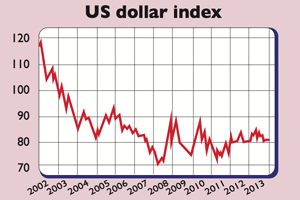The US dollar is set for a comeback in 2014
The stage is set for a higher dollar this year.

One reason for bullishness is the improving US data. The housing market is recovering and unemployment gradually falling, stimulating consumption, while the fiscal squeeze from Washington will abate this year.
Throw in signs of an uptick in business investment and 2014 "may finally be the year that the recovery gathers some speed", says Capital Economics.
The US certainly looks in better shape than any of its competitors, and that has prompted the Federal Reserve to begin tapering its quantitative-easing programme.
MoneyWeek
Subscribe to MoneyWeek today and get your first six magazine issues absolutely FREE

Sign up to Money Morning
Don't miss the latest investment and personal finances news, market analysis, plus money-saving tips with our free twice-daily newsletter
Don't miss the latest investment and personal finances news, market analysis, plus money-saving tips with our free twice-daily newsletter
While it is still loosening monetary policy, albeit more slowly, it looks set to raise interest rates far earlier than the European Central Bank or the Bank of Japan. They look more likely to step up or begin money printing rather than head towards tightening.
Relative expectations for economic growth and monetary policy are a key driver of exchange rates. The higher the short- or long-term interest rates on offer in a country, the more appealing holding its assets becomes.
The US is closest to raising interest rates, which is positive for the dollar. Long-term interest rates are also likely to rise as the economic backdrop improves.
Another effect of tapering and the prospect of eventual monetary tightening is to prompt money to leave riskier assets, such as emerging markets, and head back to the US. So emerging-market currencies are also likely to weaken against the greenback.
Another tailwind is a structural improvement in America's current-account deficit. This external deficit had reached 6.2% of GDP in 2005, a sign of a country "living dangerously beyond its means", says The Economist.
A large external gap implies a weaker currency, which is needed to correct the deficit: if exports get cheaper and imports more expensive, the trade gap will shrink. But America's current-account gap is down to around 2% of GDP largely because shale oil has reduced oil imports.
Add this all up, and Morgan Stanley reckons that the greenback, now at $1.36 to the euro, will hit $1.24 by the end of the year.
Get the latest financial news, insights and expert analysis from our award-winning MoneyWeek team, to help you understand what really matters when it comes to your finances.
MoneyWeek is written by a team of experienced and award-winning journalists, plus expert columnists. As well as daily digital news and features, MoneyWeek also publishes a weekly magazine, covering investing and personal finance. From share tips, pensions, gold to practical investment tips - we provide a round-up to help you make money and keep it.



